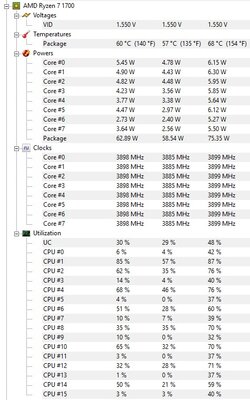Hey guys,
I recently updated to ryzen. It's a ryzen 1700 with a gigabyte ax370 gaming k3. Not the highest end board neither the lowest end.
Like a lot of AM4 boards, it have 4 phases for the CPU. I saw in a spreadsheet of all the AM4 board models that basically all the non top tier boards have the exact same mosfets model in 4+2 phase configuration.
I was watercooling and overclocking it. Like 4ghz at 1.45v. CPU temps were really good but during gaming i saw the VRM spike to around 70-80 on smaller games and 90+ on big CPU games.
Then i tested prime, and, oh boy, 120c climbing untill crash !
I dropped a fan on the backplate of the GPU pointing at the VRM cooler to see, and the temps dropped dramatically to around 60 in games and 70-80 on load (maybe more on prime i can't recall exactly but lower than previously).
Since there is no mosfet WB for my card, i decided to uninstall the loop and put back the wraith cooler. At this point, at stock but still 1.38v splike when XFR kick in, mosfet temps never exceded 65c. The fan of the cooler giving a good air flow on the heat sink.
I decided to try out an high end air cooler, the phanteks dual tower one. And right now, after 30 mins of Prime small FFT, at 3.9ghz 1.38v, the CPU is stable at 82c, package at 120w, core power at 220w, CPU+SOC at 243w, SOC mosfets at 56C AND... DRUM ROLLS... VRM mosfets at 120c !! Stable and not crashing like with the watercooling but still !
I wonder how many people have bought ryzen 7 with AIO coolers to overclock and are reading the false HWmonitor temps ?
If somebody with a ryzen build and a non high end motherboard can do some tests and share, it will be much apreciated. Also, read temps with HWinfo64, since these temps are the real correct ones. Not the 60c non moving temps of HWmonitor. I also like to know how's the temps on 6+phase boards.
Thanks for the read.
EDIT :
After half an hour of battlefield 1 64 player map, CPU is stable at 64 and Mosfet at 75. The game uses all 8 real cores at around 50-60% and barely uses the hyperthreads. The fans are barely spinning since i like it to be quiet. I think it's acceptable but in the future it might become a problem.
I recently updated to ryzen. It's a ryzen 1700 with a gigabyte ax370 gaming k3. Not the highest end board neither the lowest end.
Like a lot of AM4 boards, it have 4 phases for the CPU. I saw in a spreadsheet of all the AM4 board models that basically all the non top tier boards have the exact same mosfets model in 4+2 phase configuration.
I was watercooling and overclocking it. Like 4ghz at 1.45v. CPU temps were really good but during gaming i saw the VRM spike to around 70-80 on smaller games and 90+ on big CPU games.
Then i tested prime, and, oh boy, 120c climbing untill crash !
I dropped a fan on the backplate of the GPU pointing at the VRM cooler to see, and the temps dropped dramatically to around 60 in games and 70-80 on load (maybe more on prime i can't recall exactly but lower than previously).
Since there is no mosfet WB for my card, i decided to uninstall the loop and put back the wraith cooler. At this point, at stock but still 1.38v splike when XFR kick in, mosfet temps never exceded 65c. The fan of the cooler giving a good air flow on the heat sink.
I decided to try out an high end air cooler, the phanteks dual tower one. And right now, after 30 mins of Prime small FFT, at 3.9ghz 1.38v, the CPU is stable at 82c, package at 120w, core power at 220w, CPU+SOC at 243w, SOC mosfets at 56C AND... DRUM ROLLS... VRM mosfets at 120c !! Stable and not crashing like with the watercooling but still !
I wonder how many people have bought ryzen 7 with AIO coolers to overclock and are reading the false HWmonitor temps ?
If somebody with a ryzen build and a non high end motherboard can do some tests and share, it will be much apreciated. Also, read temps with HWinfo64, since these temps are the real correct ones. Not the 60c non moving temps of HWmonitor. I also like to know how's the temps on 6+phase boards.
Thanks for the read.
EDIT :
After half an hour of battlefield 1 64 player map, CPU is stable at 64 and Mosfet at 75. The game uses all 8 real cores at around 50-60% and barely uses the hyperthreads. The fans are barely spinning since i like it to be quiet. I think it's acceptable but in the future it might become a problem.
Last edited:

